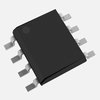Part Details for FM93C66AM8 by Fairchild Semiconductor Corporation
Results Overview of FM93C66AM8 by Fairchild Semiconductor Corporation
- Distributor Offerings: (1 listing)
- Number of FFF Equivalents: (0 replacements)
- CAD Models: (Request Part)
- Number of Functional Equivalents: (0 options)
- Part Data Attributes: (Available)
- Reference Designs: (Not Available)
Tip: Data for a part may vary between manufacturers. You can filter for manufacturers on the top of the page next to the part image and part number.
FM93C66AM8 Information
FM93C66AM8 by Fairchild Semiconductor Corporation is an EEPROM.
EEPROMs are under the broader part category of Memory Components.
Memory components are essential in electronics for computer processing. They can be volatile or non-volatile, depending on the desired function. Read more about Memory Components on our Memory part category page.
Price & Stock for FM93C66AM8
| Part # | Distributor | Description | Stock | Price | Buy | |
|---|---|---|---|---|---|---|
|
|
Rochester Electronics | EEPROM, 256X16, Serial, CMOS, PDSO8 RoHS: Not Compliant Status: Obsolete Min Qty: 1 | 433 |
|
$0.3175 / $0.5121 | Buy Now |
Part Details for FM93C66AM8
FM93C66AM8 CAD Models
FM93C66AM8 Part Data Attributes
|
|
FM93C66AM8
Fairchild Semiconductor Corporation
Buy Now
Datasheet
|
Compare Parts:
FM93C66AM8
Fairchild Semiconductor Corporation
EEPROM, 256X16, Serial, CMOS, PDSO8, 0.150 INCH, PLASTIC, SO-8
|
| Rohs Code | No | |
| Part Life Cycle Code | Obsolete | |
| Ihs Manufacturer | FAIRCHILD SEMICONDUCTOR CORP | |
| Part Package Code | SOIC | |
| Package Description | 0.150 INCH, PLASTIC, SO-8 | |
| Pin Count | 8 | |
| Reach Compliance Code | unknown | |
| ECCN Code | EAR99 | |
| HTS Code | 8542.32.00.51 | |
| Additional Feature | DATA RETENTION = 40 YEARS | |
| Alternate Memory Width | 8 | |
| Clock Frequency-Max (fCLK) | 1 MHz | |
| Data Retention Time-Min | 40 | |
| Endurance | 1000000 Write/Erase Cycles | |
| JESD-30 Code | R-PDSO-G8 | |
| JESD-609 Code | e0 | |
| Length | 4.9 mm | |
| Memory Density | 4096 bit | |
| Memory IC Type | EEPROM | |
| Memory Width | 16 | |
| Number of Functions | 1 | |
| Number of Terminals | 8 | |
| Number of Words | 256 words | |
| Number of Words Code | 256 | |
| Operating Mode | SYNCHRONOUS | |
| Operating Temperature-Max | 70 °C | |
| Operating Temperature-Min | ||
| Organization | 256X16 | |
| Package Body Material | PLASTIC/EPOXY | |
| Package Code | SOP | |
| Package Equivalence Code | SOP8,.25 | |
| Package Shape | RECTANGULAR | |
| Package Style | SMALL OUTLINE | |
| Parallel/Serial | SERIAL | |
| Qualification Status | Not Qualified | |
| Seated Height-Max | 1.75 mm | |
| Serial Bus Type | MICROWIRE | |
| Standby Current-Max | 0.00005 A | |
| Supply Current-Max | 0.001 mA | |
| Supply Voltage-Max (Vsup) | 5.5 V | |
| Supply Voltage-Min (Vsup) | 4.5 V | |
| Supply Voltage-Nom (Vsup) | 5 V | |
| Surface Mount | YES | |
| Technology | CMOS | |
| Temperature Grade | COMMERCIAL | |
| Terminal Finish | TIN LEAD | |
| Terminal Form | GULL WING | |
| Terminal Pitch | 1.27 mm | |
| Terminal Position | DUAL | |
| Width | 3.9 mm | |
| Write Cycle Time-Max (tWC) | 10 ms | |
| Write Protection | SOFTWARE |
FM93C66AM8 Frequently Asked Questions (FAQ)
-
The maximum operating frequency of the FM93C66AM8 is 1 MHz, but it can be operated at higher frequencies with reduced voltage and/or temperature.
-
To ensure data integrity during power-up and power-down cycles, it is recommended to use a voltage supervisor or a power-on reset circuit to ensure that the device is fully powered up before accessing the memory. Additionally, the device should be powered down slowly to prevent data corruption.
-
The recommended storage temperature range for the FM93C66AM8 is -65°C to +150°C. Storing the device outside of this range may affect its reliability and performance.
-
Yes, the FM93C66AM8 is rated for operation up to 125°C, but the device's performance and reliability may be affected at high temperatures. It is recommended to derate the device's operating frequency and voltage at high temperatures to ensure reliable operation.
-
To handle bus contention when multiple devices are connected to the same bus, it is recommended to use a bus arbiter or a multiplexer to ensure that only one device is accessing the bus at a time. Additionally, the devices should be designed to tri-state their outputs when not accessing the bus.
